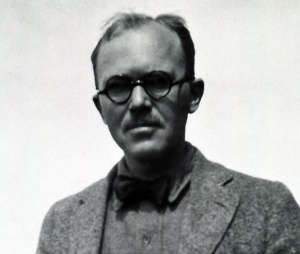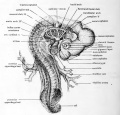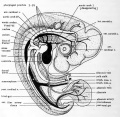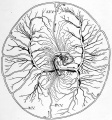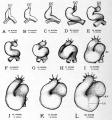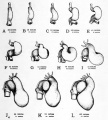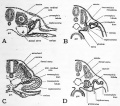Embryology History - Bradley Patten
| Embryology - 27 Apr 2024 |
|---|
| Google Translate - select your language from the list shown below (this will open a new external page) |
|
العربية | català | 中文 | 中國傳統的 | français | Deutsche | עִברִית | हिंदी | bahasa Indonesia | italiano | 日本語 | 한국어 | မြန်မာ | Pilipino | Polskie | português | ਪੰਜਾਬੀ ਦੇ | Română | русский | Español | Swahili | Svensk | ไทย | Türkçe | اردو | ייִדיש | Tiếng Việt These external translations are automated and may not be accurate. (More? About Translations) |
Introduction
Bradley Merrill Patten ( -1971) was an American embryologist, Western Reserve University, School of Medicine. Cleveland, Ohio.
Bradley Merrill Patten, the distinguished embryologist, is retiring from active service as Professor of Anatomy and Chairman of the Department of Anatomy in the Medical School, University of Michigan.
The son of a professor of zoology at Dartmouth College, he entered upon his own academic career with characteristic single-mindedness graduating from Dartmouth Phi Beta Kappa in 1911, and from Harvard Graduate School in 1914.
| Embryologists: William Hunter | Wilhelm Roux | Caspar Wolff | Wilhelm His | Oscar Hertwig | Julius Kollmann | Hans Spemann | Francis Balfour | Charles Minot | Ambrosius Hubrecht | Charles Bardeen | Franz Keibel | Franklin Mall | Florence Sabin | George Streeter | George Corner | James Hill | Jan Florian | Thomas Bryce | Thomas Morgan | Ernest Frazer | Francisco Orts-Llorca | José Doménech Mateu | Frederic Lewis | Arthur Meyer | Robert Meyer | Erich Blechschmidt | Klaus Hinrichsen | Hideo Nishimura | Arthur Hertig | John Rock | Viktor Hamburger | Mary Lyon | Nicole Le Douarin | Robert Winston | Fabiola Müller | Ronan O'Rahilly | Robert Edwards | John Gurdon | Shinya Yamanaka | Embryology History | Category:People | ||
|
1920 Chicken Embryology
Patten BM. The Early Embryology of the Chick. (1920) Philadelphia: P. Blakiston's Son and Co.
Patten BM. The closure of the foramen ovale. Am. J. Anat., 1931, 48. 19-44
1938 Developmental Defects at the Foramen Ovale
Patten BM. Developmental defects at the foramen ovale. (1938) Am J Pathol. 14(2):135-162. PMID 19970381
1949 Heart Development
Patten BM. Initiation and early changes in the character of the heart beat in vertebrate embryos. (1949) Physiol Rev. 29(1): 31-47. PMID 18125910
1951 Pig Embryology
Patten BM. Embryology of the Pig. (1951) The Blakiston Company, Toronto.
1953 Human Embryology
Patten BM. Human Embryology. (2nd end) (1953) New York, The Blakiston Company.
References
Patten BM. The Early Embryology of the Chick. (1920) Philadelphia: P. Blakiston's Son and Co.
Patten BM. The formation of the cardiac loop in the chick. (1922) Amer. J Anat. 30: 373-397.
Patten BM. Sommepfield WA. and Paff GH. Functional limitations of the foramen ovale in the human foetal heart. (1929) Anat. Rec. 44(2): 165-
Patten BM. Developmental defects at the foramen ovale. (1938) Am J Pathol. 14(2):135-162. PMID 19970381
Patten BM. Fusion of notochord to neural tube in a human embryo of the sixth week. (1946) Anat. Rec. 95} 307-11. PMID 20995923.
Patten BM. Initiation and early changes in the character of the heart beat in vertebrate embryos. (1949) Physiol Rev. 29(1): 31-47. PMID 18125910
Patten BM. Human Embryology. (2nd end) (1953) New York, The Blakiston Company.
Patten BM. Embryology of the Pig. (1951) The Blakiston Company, Toronto.
Patten BM. Overgrowth of the neural tube in young human embryos. (1952) Anat. Rec. 113: 381-93. PMID 14943968
Patten BM. and Barry A. The genesis of exstrophy of the bladder and epispadias. (1952) Amer. J Anat. 90(1): 35-57. PMID 14902688
Patten BM. Embryological stages in the development of spina bifida and myeloschisis. (1946) Anat. Rec. 94: 370-394. PMID 21020613
Patten BM. Embryological stages in the development of spina bifida and myeloschisis. (1953) Amer. J Anat. 93(3): 365-395. PMID 13104337
. (1971). In memoriam: Bradley M. Patten. Dev. Biol. , 26, 659. PMID: 4944077
. (1958). BRADLEY M. PATTEN. Med Bull (Ann Arbor) , 24, 500-1. PMID: 13625453
The closure of the foramen oval (1931) | JAMA Review of - Embryology of the Pig | Open Library
External Links Notice - The dynamic nature of the internet may mean that some of these listed links may no longer function. If the link no longer works search the web with the link text or name. Links to any external commercial sites are provided for information purposes only and should never be considered an endorsement. UNSW Embryology is provided as an educational resource with no clinical information or commercial affiliation. See also:
- University of Michigan Faculty History Bradley M. Patten
Embryological stages in the development of spina bifida and myelosclzisis
This 1946 paper presented by Patten at the 1946 Meeting of the American Association of Anatomists.
Bradley M. Patten, Department of Anatomy, University of Michigan.
Three recently acquired human embryos show progressive stages in the development of spina bifida and myeloschisis. The youngest (8 mm) exhibits a broad opening of the neural tube in the sacral region. Measurements of the sections show the bulk of the spinal cord is startlingly greater ill the region of the defect than just above or below it. Similarly in the second embryo (49 mm) there is marked overgrowth of the cord with the additional factor of local cord duplication toward one end of the defect. The third specimen (160 mm) is beginning to show degenerative changes in the open cord and clubbing of the feet. The youngest embryo indicates the cord defect is primary because it has been established well before the primordia of the neural arches have begun to take shape. Conditions presented by these specimens strongly suggest that the open neural tube is the result of local overgrowth which interfered with closure, rather than the result of a “developmental arrest” which left the tube unclosed. The importance of this possibility lies in its implications as to causation. Because of the emphasis which has been placed on the developmental arrest concept, search for causes of congenital defects has been largely directed toward conditions which might inhibit growth. If anomalies are caused also by local overgrowth, we must scrutinize causative factors of different types.
Cite this page: Hill, M.A. (2024, April 27) Embryology Embryology History - Bradley Patten. Retrieved from https://embryology.med.unsw.edu.au/embryology/index.php/Embryology_History_-_Bradley_Patten
- © Dr Mark Hill 2024, UNSW Embryology ISBN: 978 0 7334 2609 4 - UNSW CRICOS Provider Code No. 00098G
